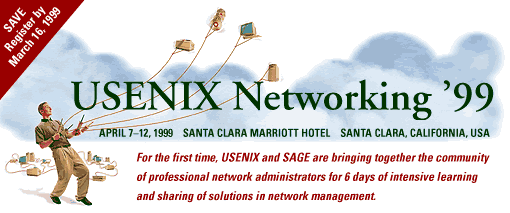


|

|
|
NETWORKING TUTORIAL PROGRAM
[Friday: F1 - F2 - F3 - F4 Saturday: S1 - S2 - S3 - S4] S4
Topics in Network Administration: Part 1 & Part 2
PART 1: IP Addressing for Surviving in the Global Internet
Who should attend: Planners and network administrators who have set up IP addresses and subnets for private networks, but now have to operate on the Internet, connecting to it with users, Internet Service Providers, and application servers potentially at different sites. Students should be proficient with basic IP addressing and subnetting, probably using class A/B/C structures, and should have a general sense of CIDR addressing. Suggested pre-tutorial reading will be available. The Internet's success has been one of its biggest problems, as techniques originally developed for a small research network have been inadequate for today's demands. To maintain backwards compatibility, many hacks to the original technology have been needed, in no area more than routing and addressing. This course identifies a wide range of techniques introduced to scale the Internet, and which need to be considered by network planners and administrators who want to work in the Internet environment. The course will begin with guidelines for systematic problem analysis to determine the application-level justification for address space and advanced connectivity, such as "multihoming." We will move into a quick review of the notation for modern addressing, and then review some of the issues of using traditional class A/B/C issues in a modern classless network - and workarounds for some of the problems, including tunneling and virtual private network methods. Roles and limitations of network address translators and proxies will also be identified. Additional addressing and naming considerations necessary to operate in the global Internet will then be reviewed, including autonomous system numbers and IP address aggregation. The course concludes with guidance about preparing the justifications for obtaining address space, and for internally administering your address space.
PART 2: Faster and Faster -Gigabit Ethernet Networks, File Servers, and Users
Who should attend: System and network administrators responsible for designing or upgrading computer networks and file servers supporting a wide variety of applications, along with managers seeking a better understanding of this rapidly advancing technology. With the increasing speed of CPUs and rising numbers of desktop and laptop systems fully utilizing Fast Ethernet bandwidth, many network backbones and central servers have been left behind with yesteryear's technology. Although the need to upgrade is often well understood, just where do you begin? This tutorial is intended for people facing just such a challenge and looks at two key areas, high performance networking with Gigabit Ethernet (1000 Mbps) and faster file serving. By the end of this tutorial you should have a sound understanding of both Gigabit Ethernet and ways of providing high performance fileserving for various applications.
Key topics include:
|
|
| |||||||||
|
| ||||||||